Exploration of Research Hotspots and Trends in Photovoltaic Landscape Studies Based on Citespace Analysis
Abstract
1. Introduction
2. Methodology
2.1. Data Collection
2.2. Overview of the Method
3. Results
3.1. Publication Volume and Citation Trends
3.2. Author Collaboration Analysis Chart
3.3. Collaboration Analysis by Country or Region
3.4. Distribution of Related Research Disciplines
3.5. Analysis of Research Institutions and Organizational Collaboration
3.6. Keyword Co-Occurrence Analysis Chart
3.7. Keyword Cluster Analysis
3.8. Keyword Time Zone Analysis Chart
3.9. Keyword Burst Analysis
4. Summary of Research Hotspots and Frontiers in Photovoltaic Landscape Studies
4.1. Ecological Impact and Assessment
4.2. Deep Integration with Human Settlements
4.3. Research on Visual Aesthetic Impact and Evaluation
5. Conclusions and Outlook
- (i)
- First, the technological advancements in photovoltaic (PV) materials are moving towards higher efficiency, greater flexibility, and enhanced aesthetic value, aimed at better adaptation to various landscape environments. Notable achievements include transparent or semi-transparent solar cells [85], colored PV module technologies [86], and flexible solar films [87]. These innovations are significant directions for future PV material development. The innovation and development of PV materials are crucial for advancing PV landscapes, but they also come with some pressing issues. Recycling PV materials will be a key focus in the future of PV landscape research. It is estimated that by 2050, the demand for photovoltaic modules (PVMs) will approach 70 TW. Over the past 50 years, the PV industry has developed rapidly, maintaining an annual growth rate of at least 25% to meet the demand for solar energy [88]. The installation of PV cells and modules has been growing exponentially, and the scale of future waste will be massive, posing significant challenges for both the ecological environment and economic development. Countries around the world are responding actively to the recycling of PV materials. Specific implementation regulations regarding the recycling and utilization of PV materials have been established in countries like the European Union, the United States, China, India, and Japan. These regulations play a crucial role in handling, collecting, and recycling electronic waste, including waste generated by solar PV [89]. As PV landscapes continue to develop rapidly, research and efforts in the recycling and utilization of PV waste materials will become a hot topic for the public and researchers. Additionally, minimizing environmental impacts during production and disposal processes, and developing more easily recyclable, less toxic PV materials will be a new direction for the PV material industry.
- (ii)
- The development of photovoltaic landscapes in future living environments will become more intelligent and interactive. Photovoltaic systems will achieve real-time monitoring, smart scheduling, and efficient demand management of energy systems through deep integration with cutting-edge technologies such as the Internet of Things (IoT), big data, and artificial intelligence. This integration will significantly enhance energy utilization efficiency; for example, smart control systems can automatically adjust the operating modes of photovoltaic landscapes in different environments to enable intelligent energy management. Currently, photovoltaic landscapes are gradually evolving towards personalization, and creating interactive and engaging photovoltaic landscapes will be an important aspect of future development. For instance, incorporating photovoltaic interactive seating and photovoltaic fountains in public spaces can enhance public engagement and experience through features like automatic sensing and activation.
- (iii)
- Policies and regulations play a crucial role in balancing the ecological, social, and economic factors in supporting PV landscapes. In terms of ecological protection, strict regulations limit PV project construction in ecologically fragile areas, nature reserves, and other sensitive zones to prevent damage to the environment. Regarding social impact, policies and regulations focus on increasing public awareness and acceptance of PV landscapes through public education and outreach, thus enhancing environmental consciousness and participation. Economically, policies and regulations enhance the feasibility of PV landscapes by offering various incentives, such as investment subsidies, preferential loans, etc., which reduce project risks and costs, and improve the return on investment. The laws, regulations, and guiding policies that promote the development of photovoltaic landscapes still have a certain lag at present [2]. Due to the relatively large number of disciplines and technologies involved in research and practice in the field of photovoltaic landscapes, how to balance its relationship with land use, ecological protection, cultural heritage protection, perceptual impact, aesthetic impact, and other fields has become a difficult problem that legislative and decision-making departments of various countries must face and is not easy to solve in the short term. Some researchers have proposed integration rules and standards applicable between photovoltaic systems and landscape environments, but overall, they are still in the exploration and suggestion stage for both and have not formed a broad consensus and effective constraints or constraints. Therefore, future legal regulations and policy guidance for photovoltaic landscapes are a key direction that researchers and decision-makers need to pay attention to. In addition, the development time of photovoltaic landscape field is relatively short, but it involves a wide range of professional knowledge, and there is a great demand for professional talents. It is necessary to establish a specialized training mechanism and training system on a global scale to cultivate composite talents who not only understand the principles and material characteristics of photovoltaic technology, but also have expertise in landscape design aesthetics, environmental science, and other aspects.
Author Contributions
Funding
Data Availability Statement
Conflicts of Interest
References
- Shubbak, M.H. Advances in solar photovoltaics: Technology review and patent trends. Renew. Sustain. Energy Rev. 2019, 115, 109383. [Google Scholar] [CrossRef]
- Kapetanakis, I.A.; Kolokotsa, D.; Maria, E.A. Parametric analysis and assessment of the photovoltaics’ landscape integration: Technical and legal aspects. Renew. Energy 2014, 67, 207–214. [Google Scholar] [CrossRef]
- Tsantopoulos, G.; Arabatzis, G.; Tampakis, S. Public attitudes towards photovoltaic developments: Case study from Greece. Energy Policy 2014, 71, 94–106. [Google Scholar] [CrossRef]
- Patel, S.; Parkins, J.R. Assessing motivations and barriers to renewable energy development: Insights from a survey of municipal decision-makers in Alberta, Canada. Energy Rep. 2023, 9, 5788–5798. [Google Scholar] [CrossRef]
- Ko, I. Landscape Disruption and Perceived Urban Bias: Sources of Opposition to Renewable Energy in South Korea; University of Washington: Seattle, WA, USA, 2023. [Google Scholar]
- Bishop, I.D.; Miller, D.R. Visual assessment of off-shore wind turbines: The influence of distance, contrast, movement and social variables. Renew. Energy 2007, 32, 814–831. [Google Scholar] [CrossRef]
- del Carmen Torres-Sibille, A.; Cloquell-Ballester, V.-A.; Cloquell-Ballester, V.-A.; Artacho Ramirez, M.A. Aesthetic impact assessment of solar power plants: An objective and a subjective approach. Renew. Sustain. Energy Rev. 2009, 13, 986–999. [Google Scholar] [CrossRef]
- Ladenburg, J. Visual impact assessment of offshore wind farms and prior experience. Appl. Energy 2009, 86, 380–387. [Google Scholar] [CrossRef]
- Scognamiglio, A. ‘Photovoltaic landscapes’: Design and assessment. A critical review for a new transdisciplinary design vision. Renew. Sustain. Energy Rev. 2016, 55, 629–661. [Google Scholar] [CrossRef]
- Sarvghad, M.; Maher, S.D.; Collard, D.; Tassan, M.; Will, G.; Steinberg, T.A. Materials compatibility for the next generation of Concentrated Solar Power plants. Energy Storage Mater. 2018, 14, 179–198. [Google Scholar] [CrossRef]
- Yadav, P.; Davies, P.J.; Palit, D. Distributed solar photovoltaics landscape in Uttar Pradesh, India: Lessons for transition to decentralised rural electrification. Energy Strategy Rev. 2019, 26, 100392. [Google Scholar] [CrossRef]
- Oudes, D.; van den Brink, A.; Stremke, S. Towards a typology of solar energy landscapes: Mixed-production, nature based and landscape inclusive solar power transitions. Energy Res. Soc. Sci. 2022, 91, 102742. [Google Scholar] [CrossRef]
- Wybo, J.-L. Large-scale photovoltaic systems in airports areas: Safety concerns. Renew. Sustain. Energy Rev. 2013, 21, 402–410. [Google Scholar] [CrossRef]
- Hou, W.W.; Liu, F.; Zhang, Y.Q.; Dong, J.Y.; Lin, S.M.; Wang, M.H. Research Progress and Hotspot Analysis of Low-Carbon Landscapes Based on CiteSpace Analysis. Sustainability 2024, 16, 7646. [Google Scholar] [CrossRef]
- Liu, J.; Xie, R.Y.; Song, A.L. Analysis on Research Frontiers and Hotspots of “Artificial Intelligence Plus Education” in China -Visualization Research Based on Citespace V. In Proceedings of the 5th International Conference on Humanities and Social Science Research (ICHSSR), Guilin, China, 26–28 April 2019; pp. 622–626. [Google Scholar] [CrossRef]
- la Tour, M.A.D. Photovoltaic and wind energy potential in Europe-A systematic review. Renew. Sustain. Energy Rev. 2023, 179, 113189. [Google Scholar] [CrossRef]
- Azpiroz, J.M.; Mosconi, E.; Bisquert, J.; De Angelis, F. Defect migration in methylammonium lead iodide and its role in perovskite solar cell operation. Energy Environ. Sci. 2015, 8, 2118–2127. [Google Scholar] [CrossRef]
- Jost, M.; Kegelmann, L.; Korte, L.; Albrecht, S. Monolithic Perovskite Tandem Solar Cells: A Review of the Present Status and Advanced Characterization Methods Toward 30% Efficiency. Adv. Energy Mater. 2020, 10, 1904102. [Google Scholar] [CrossRef]
- Makhsoos, A.; Kandidayeni, M.; Boulon, L.; Pollet, B.G. A comparative analysis of single and modular proton exchange membrane water electrolyzers for green hydrogen production- a case study in Trois-Rivieres. Energy 2023, 282, 128911. [Google Scholar] [CrossRef]
- Quan, L.N.; Zhao, Y.; de Arquer, F.P.G.; Sabatini, R.; Walters, G.; Voznyy, O.; Comin, R.; Li, Y.; Fan, J.Z.; Tan, H.; et al. Tailoring the Energy Landscape in Quasi-2D Halide Perovskites Enables Efficient Green-Light Emission. Nano Lett. 2017, 17, 3701–3709. [Google Scholar] [CrossRef]
- Middel, A.; Haeb, K.; Brazel, A.J.; Martin, C.A.; Guhathakurta, S. Impact of urban form and design on mid-afternoon microclimate in Phoenix Local Climate Zones. Landsc. Urban Plan. 2014, 122, 16–28. [Google Scholar] [CrossRef]
- Mohajerani, A.; Bakaric, J.; Jeffrey-Bailey, T. The urban heat island effect, its causes, and mitigation, with reference to the thermal properties of asphalt concrete. J. Environ. Manag. 2017, 197, 522–538. [Google Scholar] [CrossRef]
- Chu, S.; Majumdar, A. Opportunities and challenges for a sustainable energy future. Nature 2012, 488, 294–303. [Google Scholar] [CrossRef]
- Zoellner, J.; Schweizer-Ries, P.; Wemheuer, C. Public acceptance of renewable energies: Results from case studies in Germany. Energy Policy 2008, 36, 4136–4141. [Google Scholar] [CrossRef]
- Barron-Gafford, G.A.; Minor, R.L.; Allen, N.A.; Cronin, A.D.; Brooks, A.E.; Pavao-Zuckerman, M.A. The Photovoltaic Heat Island Effect: Larger solar power plants increase local temperatures. Sci. Rep. 2016, 6, 35070. [Google Scholar] [CrossRef] [PubMed]
- Fu, P.D.; Rich, P.M. A geometric solar radiation model with applications in agriculture and forestry. Comput. Electron. Agric. 2002, 37, 25–35. [Google Scholar] [CrossRef]
- Liu, Y.; Wang, Z. Research Progress and Hotspot Analysis of Urban Heat Island Effects Based on Cite Space Analysis. Land 2023, 12, 1154. [Google Scholar] [CrossRef]
- Wu, Y.N.; Wang, H.J.; Wang, Z.X.; Zhang, B.; Meyer, B.C. Knowledge Mapping Analysis of Rural Landscape Using CiteSpace. Sustainability 2020, 12, 66. [Google Scholar] [CrossRef]
- Florio, P.; Probst, M.C.M.; Schüler, A.; Roecker, C.; Scartezzini, J.L. Assessing visibility in multi-scale urban planning: A contribution to a method enhancing social acceptability of solar energy in cities. Sol. Energy 2018, 173, 97–109. [Google Scholar] [CrossRef]
- Ioannidis, R.; Mamassis, N.; Efstratiadis, A.; Koutsoyiannis, D. Reversing visibility analysis: Towards an accelerated a priori assessment of landscape impacts of renewable energy projects. Renew. Sustain. Energy Rev. 2022, 161, 112389. [Google Scholar] [CrossRef]
- Dimond, K.; Webb, A. Sustainable roof selection: Environmental and contextual factors to be considered in choosing a vegetated roof or rooftop solar photovoltaic system. Sustain. Cities Soc. 2017, 35, 241–249. [Google Scholar] [CrossRef]
- Lu, M.; Lin, A.; Sun, J. The Impact of Photovoltaic Applications on Urban Landscapes Based on Visual Q Methodology. Sustainability 2018, 10, 1051. [Google Scholar] [CrossRef]
- Redweik, P.; Catita, C.; Brito, M. Solar energy potential on roofs and facades in an urban landscape. Sol. Energy 2013, 97, 332–341. [Google Scholar] [CrossRef]
- Sattler, S.; Zluwa, I.; Osterreicher, D. The “PV Rooftop Garden”: Providing Recreational Green Roofs and Renewable Energy as a Multifunctional System within One Surface Area. Appl. Sci. Basel 2020, 10, 1791. [Google Scholar] [CrossRef]
- Moraitis, P.; Kausika, B.B.; Nortier, N.; van Sark, W. Urban Environment and Solar PV Performance: The Case of the Netherlands. Energies 2018, 11, 1333. [Google Scholar] [CrossRef]
- Schunder, T.; Yin, D.; Bagchi-Sen, S.; Rajan, K. A spatial analysis of the development potential of rooftop and community solar energy. Remote Sens. Appl. Soc. Environ. 2020, 19, 100355. [Google Scholar] [CrossRef]
- Baretzky, C.; Maheu, C.; Frericks, M.; Mayer, T.; Wuerfel, U. Unraveling the Energetic Landscape of Perovskite Solar Cells: A Synergy of 2D Drift-Diffusion Simulations and Tapered Cross-Section Photoelectron Spectroscopy. Solar RRL 2023, 7, 2300355. [Google Scholar] [CrossRef]
- von Hauff, E. 2D or not 2D: Eliminating interfacial losses in perovskite solar cells. Chem 2021, 7, 1694–1696. [Google Scholar] [CrossRef]
- Zhang, Y.; Zheng, Z.D.; Cao, X.D.; Gu, G.W.; Gan, Z.X.; Huang, R.; Guo, Y.Q.; Hou, D.J.; Zhang, X.W. Highly efficient multifunctional frosted luminescent solar concentrators with zero-energy nightscape lighting. J. Mater. Chem. A 2022, 10, 22145–22154. [Google Scholar] [CrossRef]
- Sharma, P.; Duttagupta, S.P.; Agarwal, V. A Novel Approach for Maximum Power Tracking From Curved Thin-Film Solar Photovoltaic Arrays Under Changing Environmental Conditions. IEEE Trans. Ind. Appl. 2014, 50, 4142–4151. [Google Scholar] [CrossRef]
- Zhang, K.N.; Du, X.Y.; Qiao, J.W.; Hu, H.X.; Zhang, W.Q.; Wang, L.H.; Gao, M.S.; Yin, H.; Qin, W.; Hao, X.T. Triggering favorable energy landscape: A general approach towards highly efficient and photostable organic solar cells. Energy Environ. Sci. 2022, 15, 5261–5273. [Google Scholar] [CrossRef]
- Gómez-Catasús, J.; Morales, M.B.; Giralt, D.; del Portillo, D.G.; Manzano-Rubio, R.; Solé-Bujalance, L.; Sardà-Palomera, F.; Traba, J.; Bota, G. Solar photovoltaic energy development and biodiversity conservation: Current knowledge and research gaps. Conserv. Lett. 2024, 17, e13025. [Google Scholar] [CrossRef]
- Suuronen, A.; Munoz-Escobar, C.; Lensu, A.; Kuitunen, M.; Guajardo Celis, N.; Espinoza Astudillo, P.; Ferru, M.; Taucare-Rios, A.; Miranda, M.; Kukkonen, J.V.K. The Influence of Solar Power Plants on Microclimatic Conditions and the Biotic Community in Chilean Desert Environments. Environ. Manag. 2017, 60, 630–642. [Google Scholar] [CrossRef] [PubMed]
- Cao, Q.; Liu, Y.P.; Georgescu, M.; Wu, J.G. Impacts of landscape changes on local and regional climate: A systematic review. Landsc. Ecol. 2020, 35, 1269–1290. [Google Scholar] [CrossRef]
- Haga, C.; Maeda, M.; Hotta, W.; Inoue, T.; Matsui, T.; Machimura, T.; Nakaoka, M.; Morimoto, J.; Shibata, H.; Hashimoto, S.; et al. Scenario Analysis of Renewable Energy-Biodiversity Nexuses Using a Forest Landscape Model. Frontiers in Ecology and Evolution 2020, 8, 155. [Google Scholar] [CrossRef]
- Vyas, M.; Chowdhury, S.; Verma, A.; Jain, V.K. Solar Photovoltaic Tree: Urban PV power plants to increase power to land occupancy ratio. Renew. Energy 2022, 190, 283–293. [Google Scholar] [CrossRef]
- Othman, N.F.; Su, A.S.M.; Ya’acob, M.E. Promising Potentials of Agrivoltaic Systems for the Development of Malaysia Green Economy. In Proceedings of the 2nd International Conference on Environmental and Energy Engineering (IC3E), Fujian, China, 1–3 March 2018. [Google Scholar] [CrossRef]
- Cha, J.; Lee, C.B.; Park, S.M.; Baek, D.; Kim, S.; Han, S.G.; Jin, H.; Yang, S.J.; Lim, J.; Kim, K.; et al. Lattice-matched in-situ-formed 1D perovskite phase in Multi-dimensional solar cells achieving high phase stability and favorable energy landscape. Chemical Eng. J. 2024, 484, 149208. [Google Scholar] [CrossRef]
- Block, A.B.; Palou, J.E.; Courtant, M.; Virtuani, A.; Cattaneo, G.; Roten, M.; Li, H.Y.; Despeisse, M.; Hessler-Wyser, A.; Desai, U.; et al. Colouring solutions for building integrated photovoltaic modules: A review. Energy Build. 2024, 314, 114253. [Google Scholar] [CrossRef]
- Chen, C.; Chen, Y.; Hou, J.; Liang, Y. CiteSpace II: Detecting and Visualizing Emerging Trends and Transient Patterns in Scientific Literature. J. China Soc. Sci. Tech. Inf. 2009, 28, 401–421. [Google Scholar] [CrossRef]
- Wang, J.; Liu, J.; Li, L. Detecting Photovoltaic Installations in Diverse Landscapes Using Open Multi-Source Remote Sensing Data. Remote Sens. 2022, 14, 6296. [Google Scholar] [CrossRef]
- Scognamiglio, A.; Garde, F. Photovoltaics’ architectural and landscape design options for Net Zero Energy Buildings, towards Net Zero Energy Communities: Spatial features and outdoor thermal comfort related considerations. Prog. Photovolt. 2016, 24, 477–495. [Google Scholar] [CrossRef]
- Batarseh, M.G.; Za’ter, M.E. Hybrid maximum power point tracking techniques: A comparative survey, suggested classification and uninvestigated combinations. Sol. Energy 2018, 169, 535–555. [Google Scholar] [CrossRef]
- Liu, H.; Wu, C.; Yu, Y.; Zhao, W.; Liu, J.; Yu, H.; Zhuang, Y.; Yetemen, O. Effect of Solar Farms on Soil Erosion in Hilly Environments: A Modeling Study From the Perspective of Hydrological Connectivity. Water Resour. Res. 2023, 59, e2023WR035067. [Google Scholar] [CrossRef]
- Reeves, D.C.; Rai, V.; Margolis, R. Evolution of consumer information preferences with market maturity in solar PV adoption. Environ. Res. Lett. 2017, 12, 7. [Google Scholar] [CrossRef]
- Almadhhachi, M.; Seres, I.; Farkas, I. Harnessing solar power with aesthetic innovation: An in-depth study on spherical and hemispherical photovoltaic configurations. Energy Sci. Eng. 2024, 12, 1888–1901. [Google Scholar] [CrossRef]
- Constantinou, S.; Al-naemi, F.; Alrashidi, H.; Mallick, T.; Issa, W. A review on technological and urban sustainability perspectives of advanced building-integrated photovoltaics. Energy Sci. Eng. 2024, 12, 1265–1293. [Google Scholar] [CrossRef]
- Guerin, T.F. Evaluating expected and comparing with observed risks on a large-scale solar photovoltaic construction project: A case for reducing the regulatory burden. Renew. Sustain. Energy Rev. 2017, 74, 333–348. [Google Scholar] [CrossRef]
- Lafitte, A.; Sordello, R.; de Crespin de Billy, V.; Froidevaux, J.; Gourdain, P.; Kerbiriou, C.; Langridge, J.; Marx, G.; Schatz, B.; Thierry, C.; et al. What evidence exists regarding the effects of photovoltaic panels on biodiversity? A critical systematic map protocol. Env. Evid 2022, 11, 36. [Google Scholar] [CrossRef]
- Pringle, A.M.; Handler, R.M.; Pearce, J.M. Aquavoltaics: Synergies for dual use of water area for solar photovoltaic electricity generation and aquaculture. Renew. Sustain. Energy Rev. 2017, 80, 572–584. [Google Scholar] [CrossRef]
- Chang, Y.-H.; Ku, C.-R.; Wu, B.-Y.; Lu, H.-l. Using sustainable landscape overwater equipment for improvement of aquatic ecosystem. Ecol. Eng. 2015, 83, 496–504. [Google Scholar] [CrossRef]
- Tsoutsos, T.; Frantzeskaki, N.; Gekas, V. Environmental impacts from the solar energy technologies. Energy Policy 2005, 33, 289–296. [Google Scholar] [CrossRef]
- Abidin, M.A.Z.; Mahyuddin, M.N.; Zainuri, M.A.A.M. Solar Photovoltaic Architecture and Agronomic Management in Agrivoltaic System: A Review. Sustainability 2021, 13, 7846. [Google Scholar] [CrossRef]
- Kim, T.-H.; Chun, K.-S.; Yang, S.-R. Analyzing the Impact of Agrophotovoltaic Power Plants on the Amenity Value of Agricultural Landscape: The Case of the Republic of Korea. Sustainability 2021, 13, 11325. [Google Scholar] [CrossRef]
- Stremke, S.; Schöbel, S. Research through design for energy transition: Two case studies in Germany and The Netherlands. Smart Sustain. Built Environ. 2019, 8, 16–33. [Google Scholar] [CrossRef]
- Lindberg, O.; Birging, A.; Widen, J.; Lingfors, D. PV park site selection for utility-scale solar guides combining GIS and power flow analysis: A case study on a Swedish municipality. Appl. Energy 2021, 282, 116086. [Google Scholar] [CrossRef]
- Picchi, P.; van Lierop, M.; Geneletti, D.; Stremke, S. Advancing the relationship between renewable energy and ecosystem services for landscape planning and design: A literature review. Ecosyst. Serv. 2019, 35, 241–259. [Google Scholar] [CrossRef]
- Dorokhov, A.S.; Shepovalova, O.V. Solar PV systems integrated into hardscape and sculptures. In Proceedings of the Conference of the Technologies and Materials for Renewable Energy Environment and Sustainability (TMREESGr)/Meeting of the European-Academy-for-Sustainable-Development (EURACA), Athens, Greece, 4–6 September 2019. [Google Scholar]
- Ptak, T.; Nagel, A.; Radil, S.M.; Phayre, D. Rethinking community: Analyzing the landscape of community solar through the community-place nexus. Electr. J. 2018, 31, 46–51. [Google Scholar] [CrossRef]
- Lingfors, D.; Johansson, T.; Widen, J.; Brostrom, T. Target-based visibility assessment on building envelopes: Applications to PV and cultural-heritage values. Energy Build. 2019, 204, 109483. [Google Scholar] [CrossRef]
- Lucchi, E.; Adami, J.; Stawinoga, A.E. Social acceptance of photovoltaic systems in heritage buildings and landscapes: Exploring barriers, benefits, drivers, and challenges for technical stakeholders in northern Italy. Sustain. Energy Technol. Assess. 2023, 60, 103544. [Google Scholar] [CrossRef]
- Di Rocco, A.R.; Bottino-Leone, D.; Troi, A.; Herrera-Avellanosa, D. Application of the Guidelines for the Integration of Photovoltaics in Historic Buildings and Landscapes to Evaluate the Best Practices of the Historic Building Energy Retrofit Atlas. Buildings 2024, 14, 499. [Google Scholar] [CrossRef]
- De Medici, S. Italian Architectural Heritage and Photovoltaic Systems. Matching Style with Sustainability. Sustainability 2021, 13, 2108. [Google Scholar] [CrossRef]
- Ko, I. Rural opposition to landscape change from solar energy: Explaining the diffusion of setback restrictions on solar farms across South Korean counties. Energy Res. Soc. Sci. 2023, 99, 103073. [Google Scholar] [CrossRef]
- Ioannidis, R.; Koutsoyiannis, D. A review of land use, visibility and public perception of renewable energy in the context of landscape impact. Appl. Energy 2020, 276, 115367. [Google Scholar] [CrossRef]
- Sánchez-Pantoja, N.; Vidal, R.; Pastor, M.C. Aesthetic impact of solar energy systems. Renew. Sustain. Energy Rev. 2018, 98, 227–238. [Google Scholar] [CrossRef]
- Bishop, I.D. Testing perceived landscape colour difference using the Internet. Landsc. Urban Plan. 1997, 37, 187–196. [Google Scholar] [CrossRef]
- Chiabrando, R.; Fabrizio, E.; Garnero, G. On the applicability of the visual impact assessment OAIspp tool to photovoltaic plants. Renew. Sustain. Energy Rev. 2011, 15, 845–850. [Google Scholar] [CrossRef]
- Naspetti, S.; Mandolesi, S.; Zanoli, R. Using visual Q sorting to determine the impact of photovoltaic applications on the landscape. Land Use Policy 2016, 57, 564–573. [Google Scholar] [CrossRef]
- Shaner, M.R.; Atwater, H.A.; Lewis, N.S.; McFarland, E.W. A comparative technoeconomic analysis of renewable hydrogen production using solar energy. Energy Environ. Sci. 2016, 9, 2354–2371. [Google Scholar] [CrossRef]
- Guerin, T. A case study identifying and mitigating the environmental and community impacts from construction of a utility-scale solar photovoltaic power plant in eastern Australia. Sol. Energy 2017, 146, 94–104. [Google Scholar] [CrossRef]
- Barron-Gafford, G.A.; Pavao-Zuckerman, M.A.; Minor, R.L.; Sutter, L.F.; Barnett-Moreno, I.; Blackett, D.T.; Thompson, M.; Dimond, K.; Gerlak, A.K.; Nabhan, G.P.; et al. Agrivoltaics provide mutual benefits across the food-energy-water nexus in drylands. Nat. Sustain. 2019, 2, 848–855. [Google Scholar] [CrossRef]
- Shahabuddin, M.; Rhamdhani, M.A.; Brooks, G.A. Technoeconomic Analysis for Green Hydrogen in Terms of Production, Compression, Transportation and Storage Considering the Australian Perspective. Processes 2023, 11, 2169. [Google Scholar] [CrossRef]
- Wang, W.H.; Lu, C. Visualization analysis of big data research based on Citespace. Soft Comput. 2020, 24, 8173–8186. [Google Scholar] [CrossRef]
- Li, Y.; Zheng, D.; Li, J.; Li, Z.; Liu, S.F.; Peng, L.; Yang, D. Translucent solar power for potential future implementations. J. Mater. Chem. A 2024, 12, 21605–21625. [Google Scholar] [CrossRef]
- Lei, J.S.; Zou, Y.S.; Zhang, Z.Q. Influence of p/i interface treatment on the flexible thin film solar cells for application in building integrated photovoltaics. Adv. Mater. Res. 2011, 287, 1259–1262. [Google Scholar] [CrossRef]
- Kim, J. Influence of module types on theoretical efficiency and aesthetics of colored photovoltaic modules with luminescent down-shifting layers. Sol. Energy Mater. Sol. Cells 2025, 279, 113254. [Google Scholar] [CrossRef]
- Trivedi, H.K.; Meshram, A.; Gupta, R.J. Recycling of photovoltaic modules for recovery and repurposing of materials. J. Environ. Chem. Eng. 2023, 11, 109501. [Google Scholar] [CrossRef]
- Majewski, P.; Al-shammari, W.; Dudley, M.; Jit, J.; Lee, S.-H.; Myoung-Kug, K.; Sung-Jim, K. Recycling of solar PV panels-product stewardship and regulatory approaches. Energy Policy 2021, 149, 112062. [Google Scholar] [CrossRef]
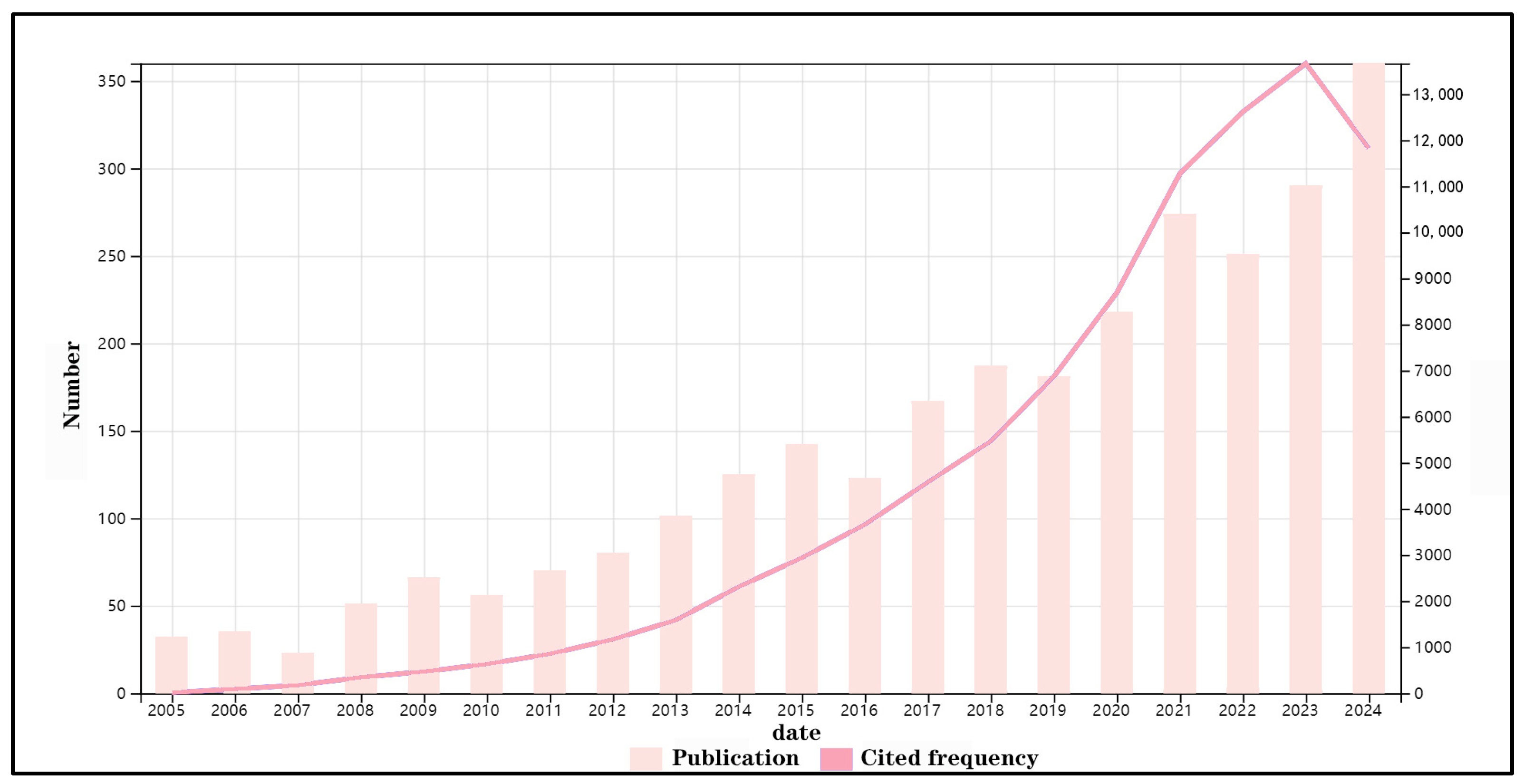
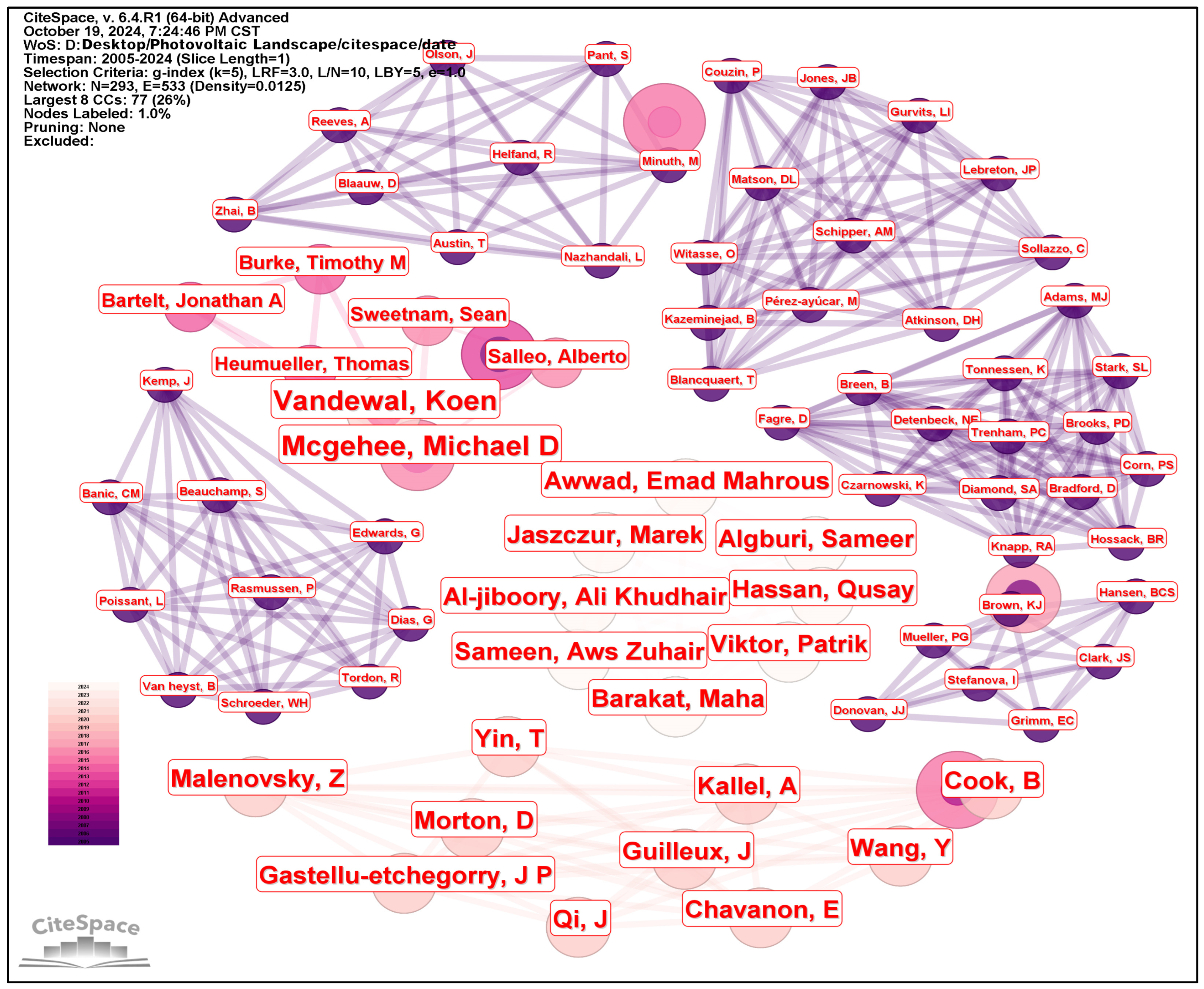
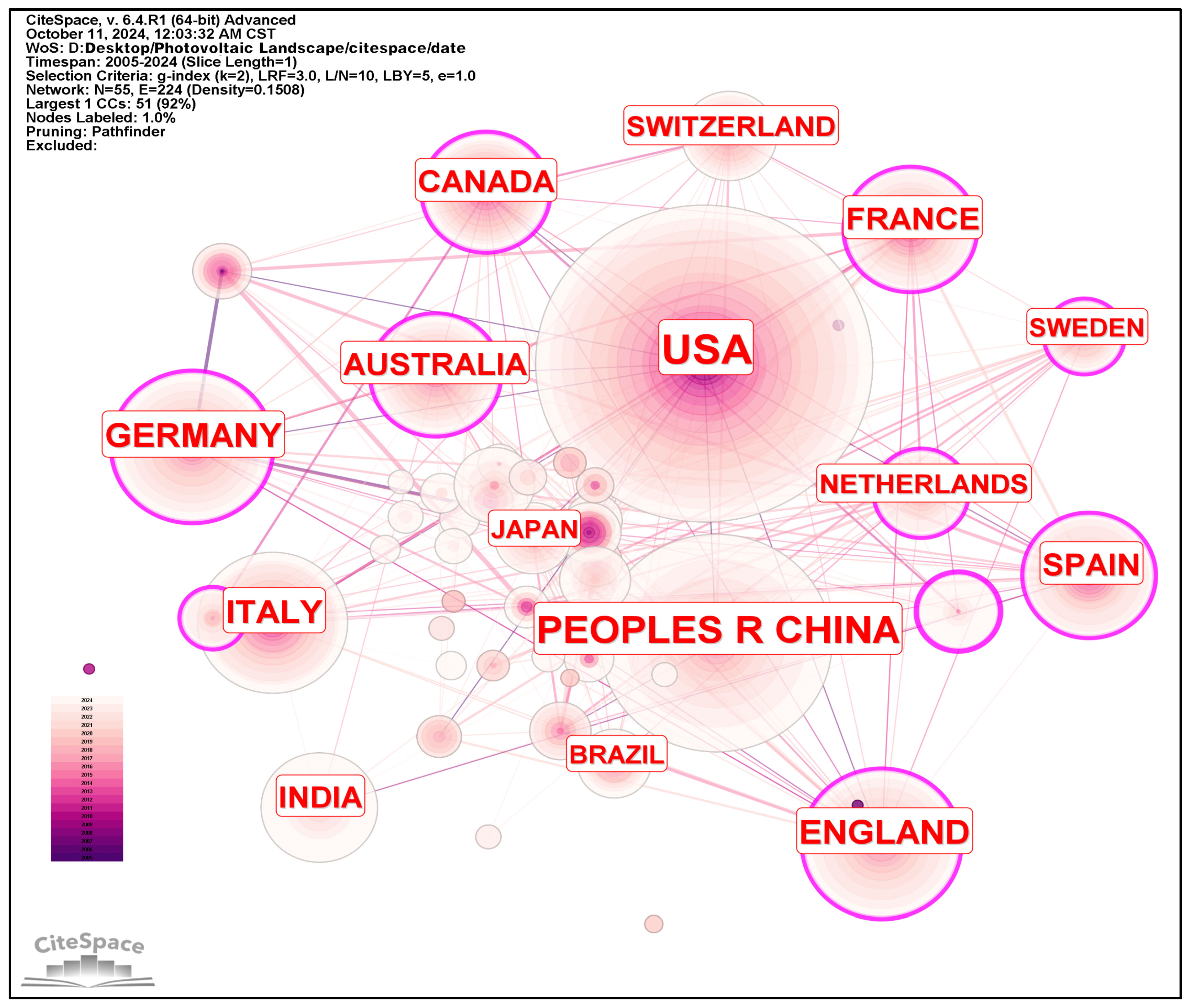

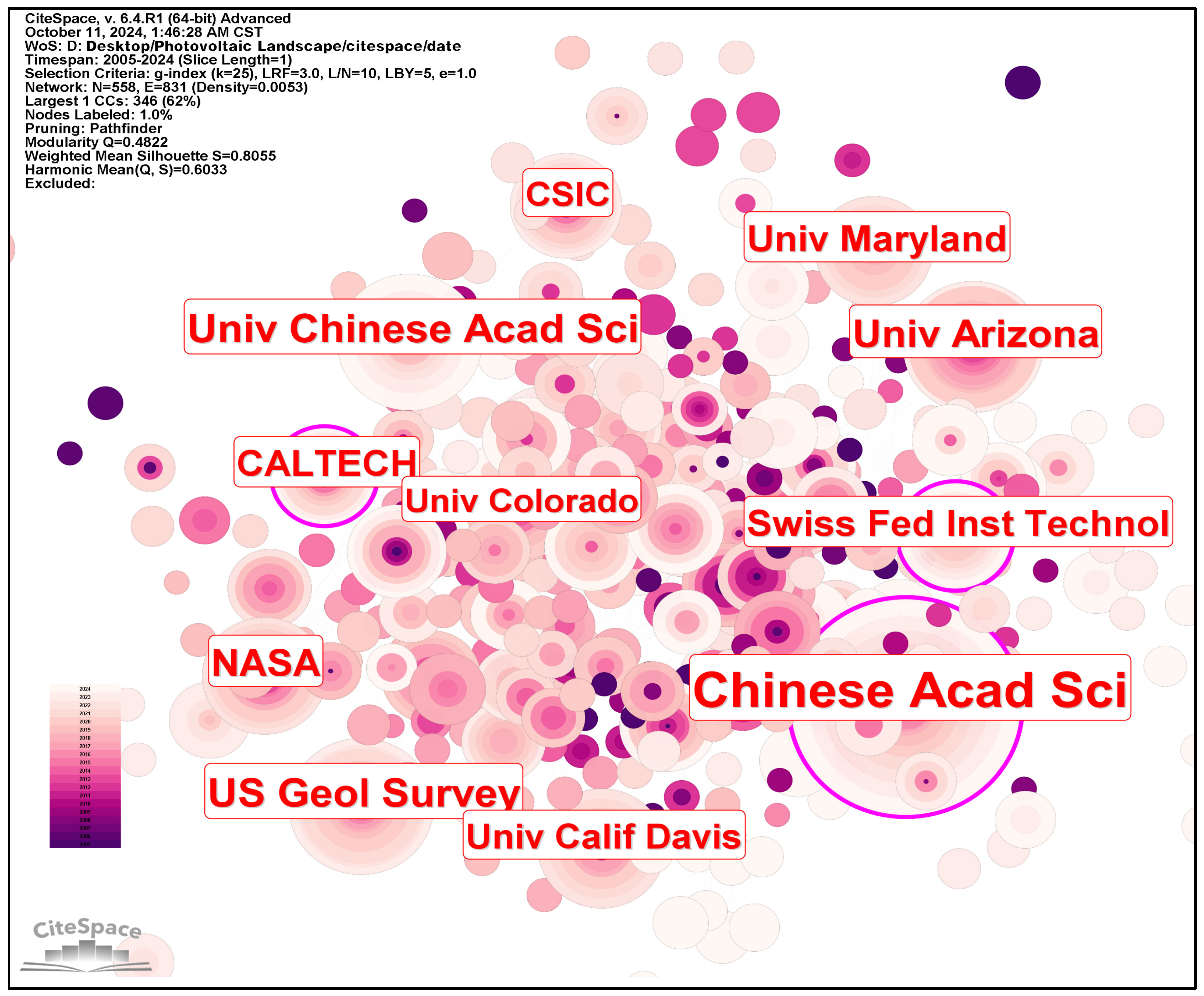

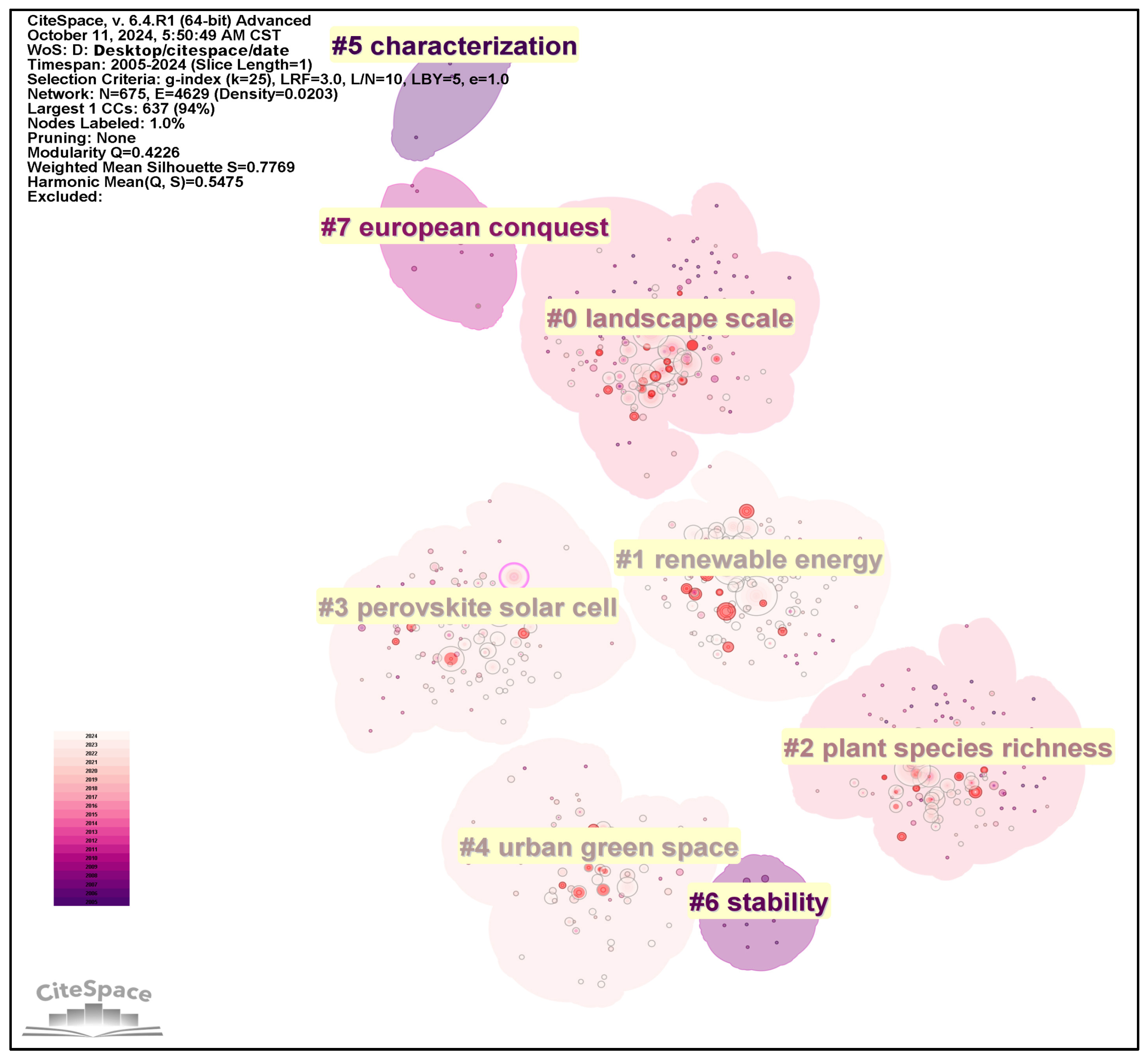
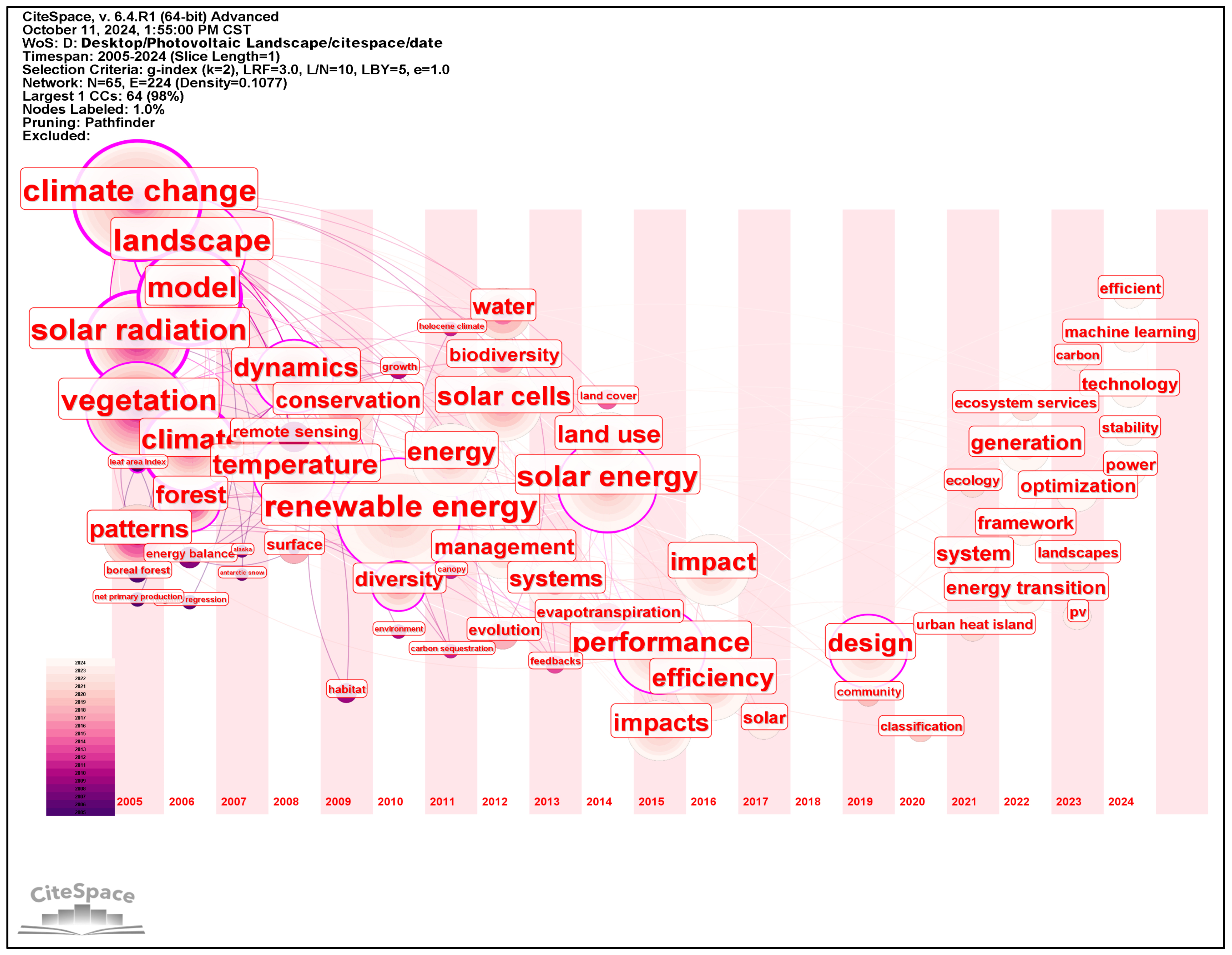
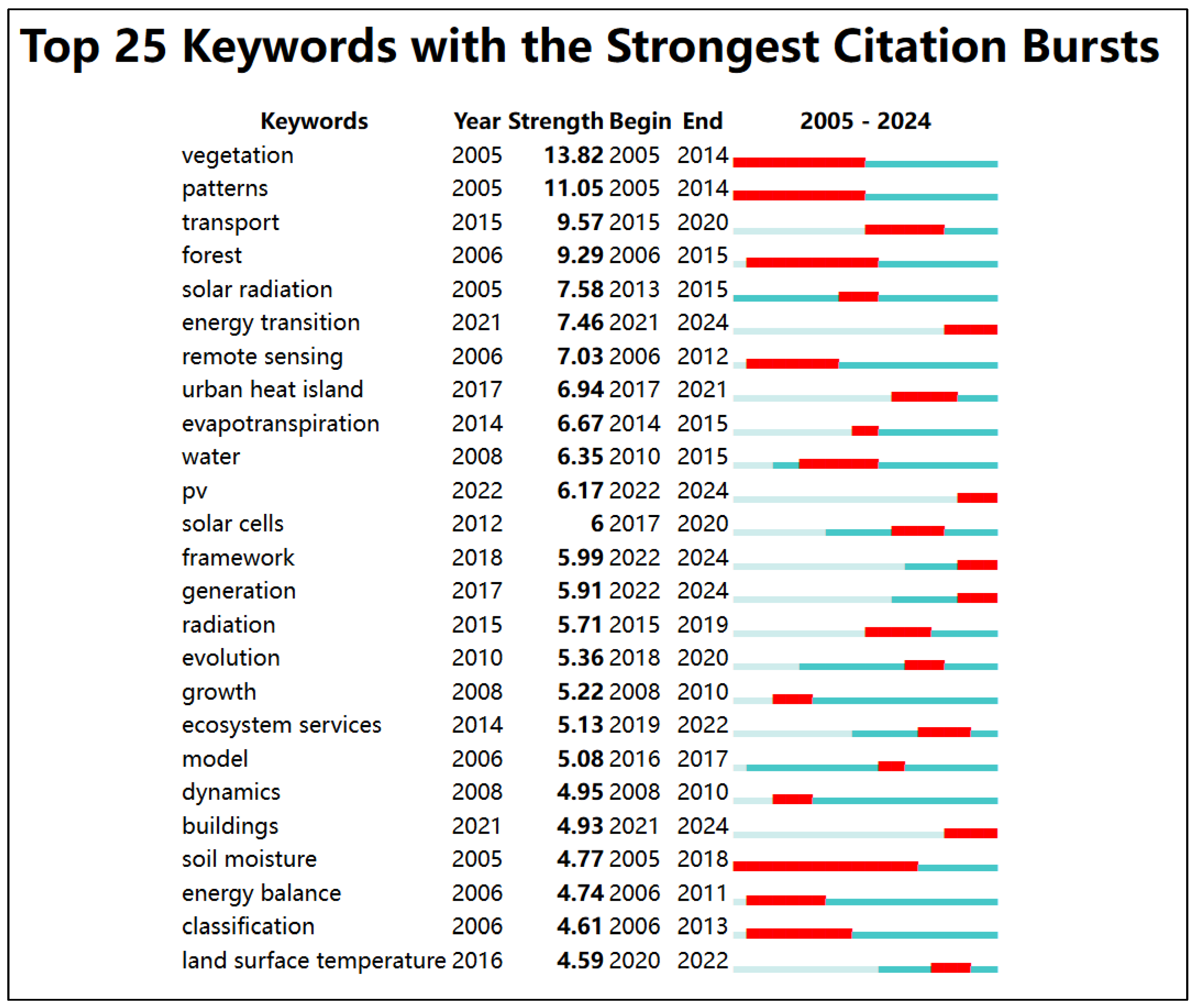
| Publications | Citations | ||||||
|---|---|---|---|---|---|---|---|
| Nearly Three Years | Average per Year | Total | |||||
| 2022 | 2023 | 2024 | |||||
| Sort | Total | Year | 11,489 | 12,643 | 11,081 | 2456.03 | 83,505 |
| 1 | Opportunities and challenges for a sustainable energy future | 2012 | 1290 | 1297 | 973 | 662.77 | 8616 |
| 2 | Lessons from nature about solar light harvesting | 2011 | 110 | 103 | 79 | 107.14 | 1500 |
| 3 | Defect migration in methylammonium lead iodide and its role in perovskite solar cell operation | 2015 | 154 | 136 | 90 | 129.7 | 1297 |
| 4 | A comparative technoeconomic analysis of renewable hydrogen production using solar energy | 2016 | 80 | 102 | 74 | 72.22 | 650 |
| 5 | The urban heat island effect, its causes, and mitigation, with reference to the thermal properties of asphalt concrete | 2017 | 119 | 107 | 94 | 71.5 | 572 |
| 6 | A comprehensive review of state-of-the-art concentrating solar power (CSP) technologies: Current status and research trends | 2018 | 109 | 86 | 62 | 72.57 | 508 |
| 7 | Impact of urban form and design on mid-afternoon microclimate in Phoenix Local Climate Zones | 2014 | 58 | 36 | 37 | 38.09 | 419 |
| 8 | Tailoring the Energy Landscape in Quasi-2D Halide Perovskites Enables Efficient Green-Light Emission | 2017 | 50 | 46 | 37 | 50.88 | 407 |
| 9 | Public acceptance of renewable energies: Results from case studies in Germany | 2008 | 39 | 27 | 20 | 23.35 | 397 |
| 10 | A geometric solar radiation model with applications in agriculture and forestry | 2002 | 31 | 16 | 26 | 16.52 | 380 |
| 11 | A Critical Review of Machine Learning of Energy Materials | 2020 | 102 | 75 | 59 | 69.4 | 347 |
| 12 | Monolithic Perovskite Tandem Solar Cells: A Review of the Present Status and Advanced Characterization Methods Toward 30% Efficiency | 2020 | 91 | 91 | 67 | 69 | 345 |
| 13 | Agrivoltaics provide mutual benefits across the food-energy-water nexus in drylands | 2019 | 65 | 100 | 91 | 55.67 | 334 |
| 14 | Quantum-size-tuned heterostructures enable efficient and stable inverted perovskite solar cells | 2022 | 70 | 124 | 105 | 100 | 300 |
| 15 | Solar energy potential on roofs and facades in an urban landscape | 2013 | 28 | 19 | 12 | 21.83 | 262 |
| Serial | Number | Central | Year | Country |
|---|---|---|---|---|
| 1 | 898 | 0.09 | 2005 | USA |
| 2 | 448 | 0.04 | 2005 | China |
| 3 | 231 | 0.15 | 2005 | England |
| 4 | 217 | 0.11 | 2005 | Germany |
| 5 | 197 | 0.03 | 2006 | Italy |
| 6 | 162 | 0.16 | 2006 | Australia |
| 7 | 162 | 0.12 | 2005 | Canada |
| 8 | 150 | 0.11 | 2006 | Spain |
| 9 | 143 | 0.17 | 2006 | France |
| 10 | 112 | 0.02 | 2009 | India |
| Serial | Number | Central | Year | Wos Discipline |
|---|---|---|---|---|
| 1 | 564 | 0.37 | 2005 | Environmental Sciences |
| 2 | 523 | 0.22 | 2006 | Energy and Fuels |
| 3 | 294 | 0.12 | 2005 | Ecology |
| 4 | 282 | 0.11 | 2005 | Geosciences, Multidisciplinary |
| 5 | 276 | 0.11 | 2007 | Materials Science, Multidisciplinary |
| 6 | 229 | 0.11 | 2006 | Environmental Studies |
| 7 | 223 | 0.1 | 2009 | Green and Sustainable Science and Technology |
| 8 | 203 | 0.03 | 2009 | Chemistry, Physical |
| Serial | Number | Central | Year | Organization |
|---|---|---|---|---|
| 1 | 107 | 0.11 | 2005 | Chinese Acad Sci |
| 2 | 38 | 0.05 | 2009 | US Geol Survey |
| 3 | 38 | 0.03 | 2014 | Univ Chinese Acad Sci |
| 4 | 37 | 0.06 | 2008 | Univ Arizona |
| 5 | 30 | 0.07 | 2005 | NASA |
| Serial | Number | Central | Year | Keyword |
|---|---|---|---|---|
| 1 | 205 | 0.14 | 2005 | climate change |
| 2 | 196 | 0.02 | 2010 | renewable energy |
| 3 | 185 | 0.09 | 2005 | landscape |
| 4 | 170 | 0.17 | 2005 | solar radiation |
| 5 | 163 | 0.09 | 2005 | vegetation |
| 6 | 152 | 0.11 | 2006 | model |
| 7 | 135 | 0.06 | 2011 | solar energy |
| 8 | 127 | 0.1 | 2005 | climate |
| 9 | 118 | 0.11 | 2012 | performance |
| 10 | 110 | 0.06 | 2008 | temperature |
| Serial | Degree | Factor | Literature |
|---|---|---|---|
| 1 | Simple objective influencing factors | color | [16,17,18,20,22,23,80,81] |
| 2 | dazzling light | [26,66,82,83] | |
| 3 | pattern | [13,17,40,81,84] | |
| 4 | Fractal degree | [14,16,28,44,83] | |
| 5 | Complex objective influencing factors | visibility | [2,3,12,13,16,20,36,37,46,83] |
| 6 | Integration degree | [17,32,33,34] |
Disclaimer/Publisher’s Note: The statements, opinions and data contained in all publications are solely those of the individual author(s) and contributor(s) and not of MDPI and/or the editor(s). MDPI and/or the editor(s) disclaim responsibility for any injury to people or property resulting from any ideas, methods, instructions or products referred to in the content. |
© 2024 by the authors. Licensee MDPI, Basel, Switzerland. This article is an open access article distributed under the terms and conditions of the Creative Commons Attribution (CC BY) license (https://creativecommons.org/licenses/by/4.0/).
Share and Cite
Jiang, F.; Wang, C.; Shi, Y.; Zhang, X. Exploration of Research Hotspots and Trends in Photovoltaic Landscape Studies Based on Citespace Analysis. Sustainability 2024, 16, 11247. https://doi.org/10.3390/su162411247
Jiang F, Wang C, Shi Y, Zhang X. Exploration of Research Hotspots and Trends in Photovoltaic Landscape Studies Based on Citespace Analysis. Sustainability. 2024; 16(24):11247. https://doi.org/10.3390/su162411247
Chicago/Turabian StyleJiang, Feihu, Chaohong Wang, Yu Shi, and Xudong Zhang. 2024. "Exploration of Research Hotspots and Trends in Photovoltaic Landscape Studies Based on Citespace Analysis" Sustainability 16, no. 24: 11247. https://doi.org/10.3390/su162411247
APA StyleJiang, F., Wang, C., Shi, Y., & Zhang, X. (2024). Exploration of Research Hotspots and Trends in Photovoltaic Landscape Studies Based on Citespace Analysis. Sustainability, 16(24), 11247. https://doi.org/10.3390/su162411247






